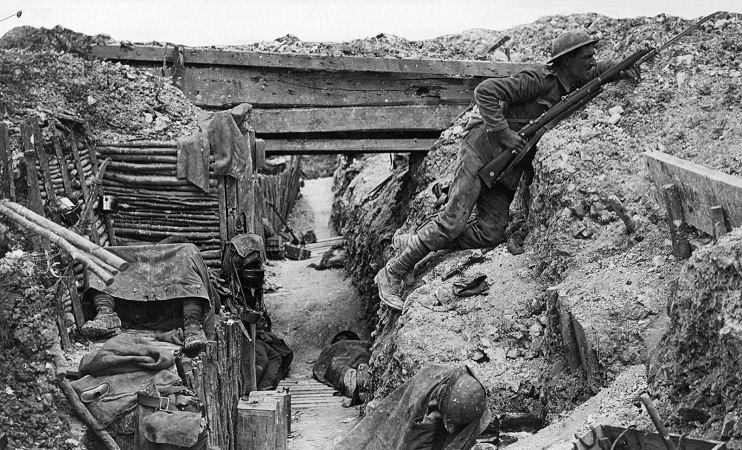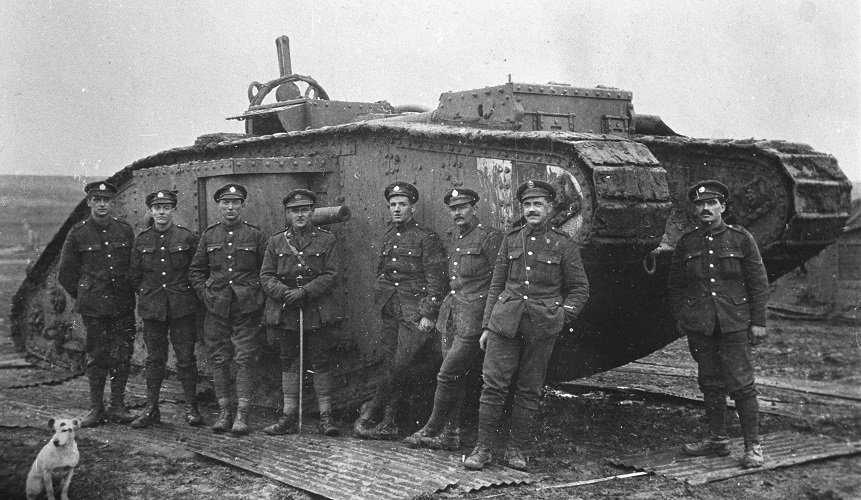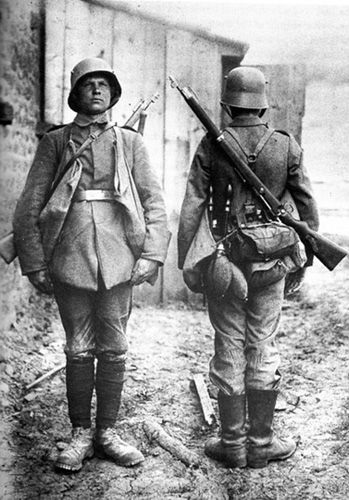● ● ●
Nazi Germany’s run of victories in
the opening round of the Second World War made Blitzkrieg—German
for lightning war—a household term. The word had
first appeared in a German military publication in 1935, and
though it was never officially adopted by the German Army,
it seemed an apt description of the high-tempo,
lighting-fast operations that characterized the 1939
invasion of Poland and the 1940 offensive that defeated
France.
Blitzkrieg appeared to herald
a revolution in the art of war. Mechanizing the
army—replacing horses with motor vehicles, including armored
fighting vehicles with cross-country capability—networking
units via radio, integrating ground and air
forces, and exploiting all these new capabilities to speed
up the tempo of operations were indeed revolutionary
developments. But there was an element of continuity in
Blitzkrieg as well, for its tactics and techniques
represented an attempt to restore to warfighting something
that seemed to have been lost: mobility. What the press
called Blitzkrieg the German Army called
Bewegungskrieg (mobile
warfare) and it was nothing new.
In 1914 the
Great War in the west
began briskly, with a series of mobile encounter battles
that, though they cost both sides heavily, failed to produce decisive
results. There were two reasons for this. First, the great
increase in Europe’s population, rail transportation, the
telegraph and the evolution of the administrative state made
possible the mobilization and sustainment of armies vastly
larger than those that Frederick the Great or even Napoleon
had ever commanded. Second, the warlike products of the
Industrial Revolution—the magazine rifle, the machine gun,
breech-loading recoil-stabilized rifled artillery—vastly
increased those armies’ firepower. The result, after the
initial clash, was stalemate. Long ago
Clausewitz had noted
that defense is the stronger form of war, and so it proved
on the Western Front. The situation was somewhat different
in the east, where the ratio of forces to space was much
lower and mobile operation remained possible. But in France
and Flanders, the two sides soon became mired in
Stellungskrieg—positional warfare. The
trench lines
stretched from the Swiss frontier to the Channel coast.
There was no way around and, seemingly, no way through. Repeated
offensives, mostly by the French and British armies,
invariably at great cost, failed to break the deadlock.

The deadlock: A British
front-line trench, Western Front, 1917 (Imperial War Museum)
The tactical problem was obvious
enough: Against defenders positioned in trenches and
strongpoints behind multiple belts of barbed wire, well
supplied with machine guns and supported by artillery,
advancing infantry was terribly vulnerable. Even if the
attackers managed to capture a stretch of the enemy line, it
proved nearly impossible to convert the break-in to a
breakthrough. Decimated and exhausted, the troops of the
first wave could only hang on and wait for the arrival of
the reserves whose task it was to continue the advance. But
those reserves could not be committed to action until
commanders had accurate information about the situation in
the zone of battle—where the break-in attempt had succeeded,
where it had failed—and such information was hard to come
by. Telephone lines could be cut, radios were too cumbersome
to go forward with the attackers, messengers might be
killed, wounded, captured or simply get lost. When reliable
information came finally to hand, it was usually too late
for the attacker to exploit a break-in. With time on his
side, the defender could rush reinforcements to the
threatened area by road and rail much faster than the
attacker's reinforcements could struggle over the
devastated,
muddy terrain of no man’s land.
The Allies initially attempted to break
the deadlock by applying firepower in the form of more and
heavier artillery. The enemy’s line would be pulverized—strongpoints
smashed, trenches caved in, barbed-wire entanglements swept
away—by a bombardment lasting days or even weeks. Then the
infantry would simply walk forward and occupy the devastated
area. But the Germans soon evolved a system of defense that
greatly mitigated the destructive effects of shellfire:
multiple trench lines four to six miles in depth, reinforced
underground galleries to protect their troops, reserves
positioned to deliver prompt counterattacks. Moreover,
prolonged bombardment canceled what little was left of the
element of surprise. Already it was easy to spot the
lengthy, ponderous build-up for a major offensive: the
huge ammunition and supply dumps, the arriving
reinforcements, the front-line preparations. A long
bombardment merely signaled to the defender that the
already-expected attack was imminent. So one offensive after
another faltered and faded out and the terrible butcher’s
bill lengthened—but the generals remained undaunted. Surely,
they argued, if enough explosives were poured on the enemy,
his defenses must collapse. Thus after each
unsuccessful offensive the cry went up for more and still
more guns and shells.
But necessity is the mother of
invention, and other more innovative thinkers on the Allied
side were pondering a different solution. They agreed with
the generals that what was needed to sustain the attack was firepower—but protected, mobile firepower,
capable of moving forward with the infantry to provide on-the-spot
support.
The idea was nothing new. Armored
fighting vehicles of one kind or another had been proposed
or described for centuries before the Great War. Leonardo da
Vinci sketched his design for such a machine in 1487. Over
time the concept was taken up by numerous writers, especially H.G. Wells in his 1898 novel, The War of the Worlds,
and in his 1903 short story, “The Land Ironclads.” In the
first decade of the twentieth century there were several
proposals for tracked armored vehicles powered by internal
combustion engines and armed with light cannon. But orthodox
soldiers, already grappling with the military implications
of modern rifles, machine guns and artillery, rejected them.
Only as the reality of the Western Front deadlock sank
in did minds begin to change.

A Mark V (M) heavy
tank and its crew. It was armed with two 57mm guns and four
machine guns (Photo: Imperial War Museum)
Britain is generally credited as
the birthplace of the tank (though armored vehicles were
being developed in other countries as well), and there the
idea was promoted not by the War Office but by Winston
Churchill, First Lord of the Admiralty. His always-active
imagination was fired by the concept of a “landship,” an
armored vehicle capable of crossing no man’s land, crushing
barbed-wire obstacles and suppressing the enemy’s defensive
fire with its machine guns and light cannon. Infantry,
advancing close behind the tanks, would then attack through
the breach created—without having suffered crippling losses.
Numerous designs were tried and discarded before a practical
armored fighting vehicle was developed, successfully tested
and accepted for service: the Mark I tank, nicknamed
Mother.
With casualties mounting, even the
most skeptical generals were willing to give the tank—the name
originated as a cover designation suggesting a mobile water
carrier—a try. Some thirty tanks were committed to action during
the Battle of the Somme (1916). It was an unimpressive debut. The
ground was unfavorable, the breakdown rate was high and, as
tank commanders had protested before the battle, their
numbers were insufficient. These deficiencies were gradually
remedied, and in the last two years of the war British and
French tanks played an increasingly large and
important part in Western
Front battles. Though by the end of the war there were
visionaries on the Allied side who foresaw for the tank the
decisive role in future war, most soldiers regarded it as an
infantry support weapon—useful, no doubt, but no more than
that.
In Germany, though tank development
was neglected the problem of the trench stalemate was not.
It was tackled, however, by the development of new tactics
rather than new technologies. The
Germans’ analysis disclosed what had been lacking in
earlier offensives: Since the
massive preparations for an attack were difficult if not
impossible to conceal, the enemy was unlikely to be
surprised. But the effects of surprise—shock,
confusion, disorganization—could
be replicated by other means. So instead of a preparatory
artillery bombardment lasting days or weeks, the attack
would be preceded by a brief but intense “hurricane
bombardment” lasting no more than four or five hours. Its
principal purpose would be to cut the defender's communications,
isolate his forward troops and sow confusion up the enemy
chain of command; to that end
the artillery would fire a high proportion of smoke and gas
shells. When the attack went in, the first wave would consist of specially
trained assault troops (Stoßtruppen). Operating in
platoon or company strength, they would infiltrate the
defenses, bypassing centers of resistance, making for
the enemy’s vulnerable rear areas. Behind them would follow
larger battle groups. Their task was to mop up isolated
defenders, consolidate the ground gained, and clear the way
for main body of attacking infantry.

Stoßtruppen:
German assault infantry. The cloth bags slung over the
shoulders carried stick grenades. (Bundesarchiv)
These new tactics demanded a
wholesale reorganization of the infantry. Thus the infantry
battalions of the 1917-18 Mob-Division had
three
companies, each with three rifle platoons, plus a heavy
machine gun company and a trench mortar platoon. Each rifle
platoon had three squads with light machine guns and grenade
launchers. Overall, the rifle strength of the infantry
division was reduced by one-third in exchange for a much
larger allotment of light and heavy machine guns, grenade
launchers, mortars and infantry guns. The guiding principle
was to provide units at each echelon of command with all the
weapons needed to accomplish their mission: Einheit
(unity) as the German Army called it, or in modern parlance
combined arms doctrine. In addition the Mob-Division had an assault
battalion (Sturmabteilung)
consisting of the elite Stoßtruppen.
They were equipped with light machine guns,
grenade launchers, light mortars and flamethrowers, and
included a pioneer (combat engineer) company.
These new assault tactics were first employed on a large scale during
the Battle of Verdun in 1916. They were used with great
success on the Eastern Front in 1917-18, during the
Austro-German offensive in Italy (late 1917), and on the
Western Front for Germany’s Victory Offensive in 1918.
It
was the combination of the Allied technological solution—the
tank—with the German tactical solution that led to the
postwar development of mobile warfare doctrine—Blitzkrieg.
● ● ●